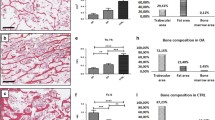Abstract:
Osteogenesis and angiogenesis occur in a coordinated manner in skeletal tissue, so that impaired angiogenesis is associated with decreased bone formation in aged subjects. However, the interaction between bone endothelium and osteoblastic cells is poorly understood. Parathyroid hormone-related protein (PTHrP), a bone factor which modulates osteoblastic cell growth and/or differentiation, stimulates vascular endothelial growth factor (VEGF), a potent angiogenic factor, in primary cultures of human osteoblastic (hOB) cells. In the present study, we examined the age-related changes of both factors in these cells. Human OB cells were isolated from trabecular bone samples from knee or hip explants obtained from 45 osteoarthritic patients: 12 <60 years (21–59 years), 5 women and 7 men, and 33 >60 years (61–82 years), 20 women and 13 men. Cell total RNA was isolated, and mRNA analysis was performed by reverse transcription-polymerase chain reaction. Relative ratios of amplified products with respect to glyceraldehyde-3-phosphate dehydrogenase were then calculated. PTHrP and VEGF were measured in the cell-conditioned medium, after stimulation with (or without) 10 nM 1,25(OH)2D3 for 72 h, using specific immunoradiometric assay and a competitive immunoassay, respectively. A positive correlation was found between PTHrP and VEGF (both mRNA and secreted protein), and also between PTHrP mRNA and the secreted protein levels, in these cells. PTHrP, both mRNA and protein secretion levels, and VEGF secreted values were higher in knee hOB cells than in hip hOB cells only in the younger group. In addition, a decrease in the secreted levels of these factors occurs with aging only in hOB cells from knee. Treatment with 10 nM 1,25(OH)2D3 induced a lower inhibitory response of PTHrP secretion, and a higher stimulatory response of secreted VEGF, in hOB cells with age. These findings indicate that age-related bone loss in humans is associated with a decrease in the osteoblastic secretion of both PTHrP and VEGF in the knee, a predominantly trabecular bone. These data might provide a rationale to explain the impaired angiogenesis associated with trabecular bone loss in aging.
Similar content being viewed by others
Author information
Authors and Affiliations
Additional information
Received: 11 January 2002 / Accepted: 17 June 2002
Correspondence and offprint requests to: María Eugenia Martínez, PhD, Hospital La Paz, Paseo de la Castellana, 261, E-28046 Madrid, Spain. Tel: +34 629613634; Fax: +34 917277050; e-mail: eugemartinez@hulp.insalud.es
Rights and permissions
About this article
Cite this article
Martínez, P., Esbrit, P., Rodrigo, A. et al. Age-Related Changes in Parathyroid Hormone-Related Protein and Vascular Endothelial Growth Factor in Human Osteoblastic Cells . Osteoporos Int 13, 874–881 (2002). https://doi.org/10.1007/s001980200120
Issue Date:
DOI: https://doi.org/10.1007/s001980200120




